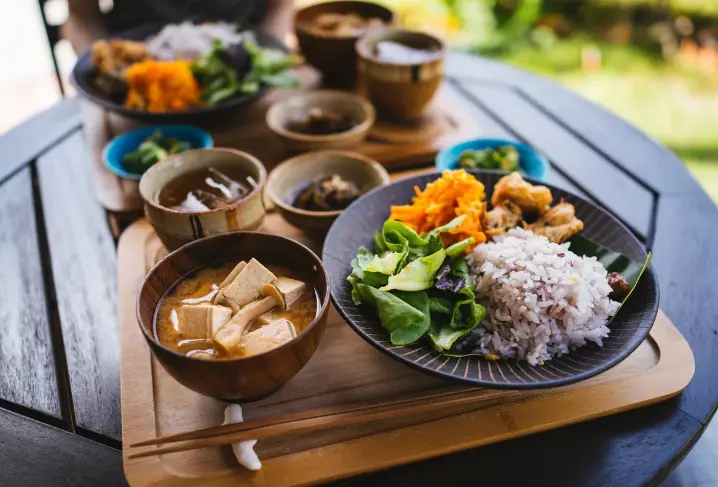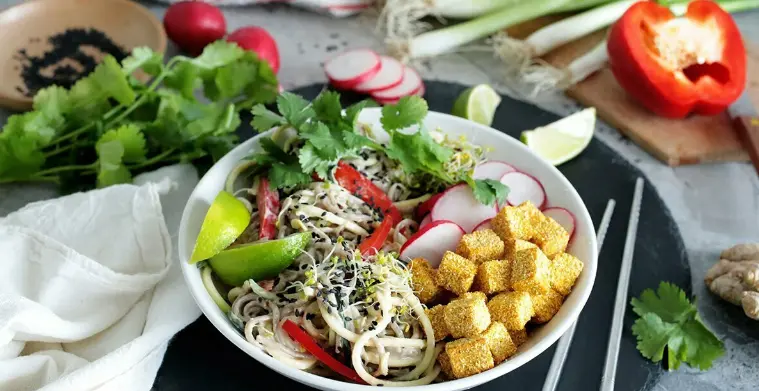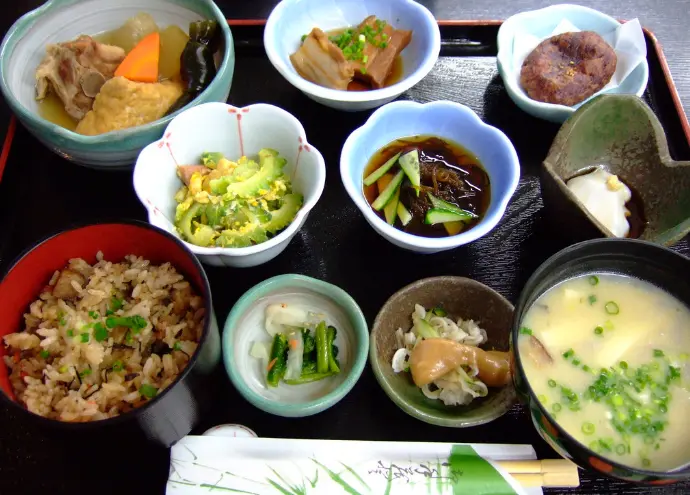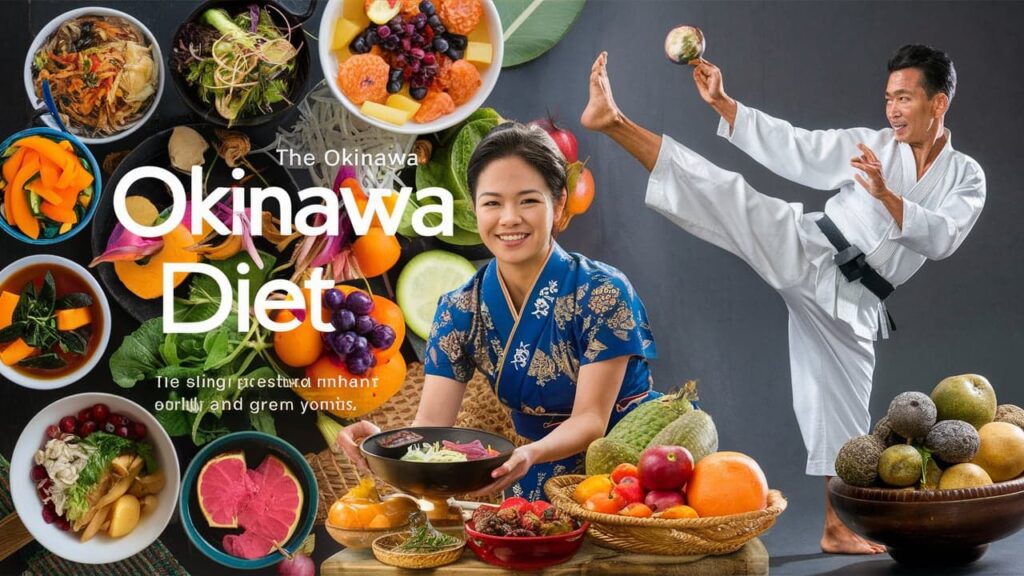What Is the Okinawa Diet? It is a traditional diet attributed to the inhabitants of the Japanese island of Okinawa, who are known for their long lives and health. The Okinawa diet is believed to contribute to this longevity by reducing the risk of chronic diseases such as heart disease, diabetes, obesity, and some cancers. and in this article, we will know more about it and how to keep your body healthy by it.
What Is the Okinawa Diet?

many people ask What Is the Okinawa Diet? indeed Okinawa diet is a diet rich in carbs and vegetables, and the Okinawa diet refers to the traditional dietary habits and lifestyle of people living on the Japanese island of Okinawa.
Okinawa’s traditional diet is low in calories and fat while high in carbs, focusing on vegetables and soy products with small amounts of pasta, rice and fish. The health benefits associated with the traditional Okinawa diet led to a mainstream version aimed at promoting weight loss.
Main ingredients of Okinawa diet
- Plant foods: Okinawa diet is rich in plantbased foods such as vegetables, fruits, and whole grains. This diet pattern is characterized by a little red meat and saturated fat.
- Plant proteins: Okinawa diet relies on plant protein sources such as beans, tofu and soya, which contribute to reducing the risk of chronic diseases.
- Low calorie consumption: It is believed that low calorie intake can lead to an increase in life expectancy and reduce the risk of chronic diseases.
- Social life and physical activity: In addition to diet, Okinawa’s population is encouraged to engage in regular physical activity and participate in social activities, contributing to good physical and mental health and it also encourages you to take IGNITE and HoneyBurn
What Is the Okinawa Diet Basic Foods?
Many of the benefits of the Okinawa diet are attributable to supplying the body with whole foods rich in nutrients and antioxidants. Essential nutrients are important for the body’s function properly, while antioxidants protect your body from cellular damage. Basic foods in Okinawa’s traditional diet are:
- Vegetables (5860%): sweet potatoes (orange and purple), seaweed, bamboo buds, decon radish, bitter melon, cabbage, carrots, Chinese okra, pumpkin, green papaya.
- Cereals (33%): wheat, rice and pasta.
- Soy foods (5%): tofu, miso, nato, edamame.
- Meat and seafood (12%): mostly white fish and seafood.
- Others (1%): herbs and spices known for their health benefits, such as turmeric, jasmine tea, etc.
Benefits of Okinawa’s diet
Okinawa’s diet has many health benefits, often due to its high antioxidant content and high-quality nutritious foods, including:
- The most important benefit of the traditional Okinawa diet is its apparent impact on health. Okinawa is home to more centenarians, or people living up to at least 100 years, than anywhere else in the world.
- Okinawa’s traditional diet consists primarily of plant-based foods that provide strong antioxidants and anti-inflammatory abilities that promote health, as research suggests that antioxidant-rich foods may help slow the aging process by protecting the body’s cells from free root damage and reducing inflammation.
- Okinawa residents suffer from less chronic diseases, such as heart disease, cancer and diabetes, where Okinawa foods are characterized by essential nutrients, fibre and anti-inflammatory compounds, while being low in calories, refined sugar and saturated fat.
- Increasing life span: The Okinawa diet is thought to contribute to increasing the long-life rates of the islanders.
- social activity and a healthy diet on the Okinawa diet contribute to improving mental health and general happiness.
Okinawa Diet Basic Rules

If you want ti know What Is the Okinawa Diet here are the main rules of it which can help you a lot:
- Focusing on plant-based foods: The diet is mainly based on vegetables, fruits, whole grains,legume, and eat Hidragenix.
- Consumption of moderate amounts of fish: Fish are an important source of protein in the Okinawa diet, but are consumed in moderate amounts compared to other types of Asian diets.
- Eating small quantities of red meat: red meat and its products are consumed in small quantities on the Okinawa diet.
- Using soybean oil: Soybean oil is the main source of fat in the Okinawa diet.
- Eating moderate quantities of calories: Okinawans tend to eat less calories than populations in Western countries.
- Regular physical activity: Physical activity is an important part of Okinawa’s lifestyle.
What Is the Okinawa Diet secret?
Geographical scientist and writer Dan Botner published a report on CNBC, carried by Deutsche Welle, in which he said that the secret of the Japanese island lies in the diet of its inhabitants, that is, in “Hara Hashi Poo.”
Conviction
In the sense of eating only to a maximum of 80% of what we want to eat so that we do not reach the level of satiety. So we control the calorie rate that we give to our bodies, and Botner explains that the rate in Okinawa residents is only 1,900 calories a day.
Slow eating
Which makes a lot of sense, doctors have found that the body needs about 15 to 20 minutes to feel full, which means that the more slowly we eat, the more timely we feel full.
In a CNBC dialogue, nutritionist Brian Wansenkin says: There is a clear difference in the number of calories recorded in the United States when he declares himself “full” and in the Okinawa Islander when he says “he is no longer hungry” The researcher summarized that “we are stealthily overweight because we eat too much, or because we eat more every day without thinking about it.”
Potential risks of Okinawa diet
Despite the potential health benefits of the Okinawa diet, it may involve some risks and disadvantages:
- Dependence on local ingredients: Okinawa Diet relies heavily on local food ingredients such as orange sweet potatoes, tofu, barley flour, etc. These ingredients may not be readily available or affordable in all regions.
- Behavioral changes: Strictly following the Okinawa diet requires significant changes in dietary behaviors, which can be a challenge for some people.
Potential nutrient deficiencies
- Concern about vitamin B12: Due to reduced consumption of meat and dairy products, there may be a risk of vitamin B12 deficiency, which is essential for the health of nerves and red blood cells.
- Getting calcium: It can be difficult to get enough calcium from only plant sources, which can increase the risk of osteoporosis.
- Iodine: The Okinawa diet depends on fish as the main source of iodine, but some people may not get enough, especially if they do not eat fish regularly.
Read more: Flossing: Is It Really Necessary?
Potential health risks

- Interactions with medications: Some ingredients in Okinawa diet, such as soy, may interact with some drugs, so it is important to consult a doctor before following this diet if you are taking any medications.
- Concerns about hormones: Some foods in the Okinawa diet, such as soybeans, contain hormone-like compounds, and may have health effects on some people, especially pregnant or lactating women.
In conclusion, we have known What Is the Okinawa Diet? and it’s an example of how diet and lifestyle affect our health and existence. By adopting a great diet rich in plant foods and reducing calories, in addition to being generally active in particular, and their life expectancy can still affect their overall quality of life

